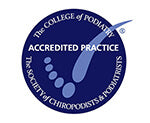Metatarsalgia and Morton’s Neuroma

What is Metatarsalgia?
This is an umbrella term that describes pain in the metatarsal area of the forefoot. Abnormal pressure loading can be a common cause of pain in this area which can be attributable to footwear choices, foot posture, reduction of the natural cushion made of fat and fibrous tissue under the ball of the foot or over-use.
Treatment for Metatarsalgia
Metatarsalgia treatment includes possible changes to footwear, cushioning or gel insoles, or even a detailed assessment of walking & foot and leg postures in order to prescribe specialised insoles called orthoses. In some instances referral for surgical management from a podiatric surgeon may be necessary.
What is a Morton’s Neuroma?
There are nerves in feet which run up towards the toes, finally branching off to give sensation into the toes themselves. Sometimes these nerves can become thickened or inflamed especially between the 3rd or 4th toes and 2nd and 3rd toes.
The inflammation or thickening of the nerve is the result of the metatarsal bones, which run alongside the nerves, causing mechanical irritation to the nerve at the level of the main toe joint.
This mechanical irritation which predisposes people to neuromas is related to abnormal biomechanics, tight or compressive footwear.
The anatomy of the bones of the foot is also thought to contribute to the development of Morton's neuroma. For example, the space between the long bones (metatarsals) in the foot is narrower between the second and third and between the third and fourth metatarsals. This means that the nerves that run between these metatarsals are more likely to be compressed and irritated. Wearing narrow shoes can make this compression worse.
Sometimes, other problems can contribute to the compression of the nerve. These include the growth of a fatty lump (called a lipoma) and also the formation of a fluid-filled sac that can form around a joint (a bursa). Also, inflammation in the joints in the foot next to one of the digital nerves can sometimes cause irritation of the nerve and lead to the symptoms of neroma
Symptoms of Morton’s Neuroma
People with Morton's neuroma usually complain of pain that can start in the ball of the foot and shoot into the affected toes. Some people just have toe pain. There may also be burning and tingling of the toes. Some people describe the pain that they feel as being like walking on a stone or a marble.
Symptoms can be made worse if you wear high-heeled shoes. The pain is relieved by taking your shoe off, resting your foot and massaging the area. You may also experience some numbness between the affected toes.
The symptoms can vary and may come and go over a number of years. For example, some people may experience two attacks of pain in a week and then nothing for a year. Others may have regular and persistent (chronic) pain.
Treatment for Morton’s Neuroma
Non-surgical treatments may be all that are needed for many people with a Morton's neuroma. From the simple to the more technical, they include the following:
- Choosing the right footwear is very important. If you have a Morton's neuroma you should avoid high-heeled and narrow or pointed-toe shoes. Also avoid shoes with thin soles. Wear comfortable, wide-fitting shoes which don't squash your feet.
- Insoles inside the shoes are often helpful. Shoe inserts (also called orthoses) for this condition can be designed by your podiatrist at city foot health. To protect the nerve the insoles will have a inbuilt metatarsal dome pad which will increase the space between the metatarsals allowing the neuroma to relax.
- Steroid or local anaesthetic injections (or a combination of both) into the affected area of the foot may be needed if the simple footwear changes do not fully relieve symptoms. This may be done by a specialist in ultrasound scans (radiologist), who injects whilst doing the ultrasound scan. It may also be done by a podiatrist.


